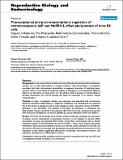Por favor, use este identificador para citar o enlazar a este item:
http://hdl.handle.net/10261/289844COMPARTIR / EXPORTAR:
 SHARE SHARE
 CORE
BASE CORE
BASE
|
|
| Visualizar otros formatos: MARC | Dublin Core | RDF | ORE | MODS | METS | DIDL | DATACITE | |

| Título: | Transcriptional and post-transcriptional regulation of retrotransposons IAP and MuERV-L affect pluripotency of mice ES cells |
Autor: | Ramírez, Miguel Ángel ; Pericuesta Camacho, Eva; Fernández González, Raúl; Moreira, Pedro Nuno; Pintado, B.; Gutiérrez-Adán, Alfonso CSIC ORCID | Fecha de publicación: | 2006 | Editor: | BioMed Central | Citación: | Reproductive Biology and Endocrinology 4: e55 (2006) | Resumen: | Background In the mouse, culture of embryonic stem (ES) cells may decrease their pluripotency and give rise to foetal abnormalities in recipient embryos. These abnormalities are frequently associated with both, chromosome abnormalities or epigenetic alteration of imprinting genes; however, little is known about the epigenetic stability of endogenous retrotransposable elements (REs). In our laboratory, we came across a R1 ES cell line, which at passage 27, lost the ability of germline transmission and started inducing the kinky tail phenotype in all chimeric animals produced with it. Methods In order to investigate whether this phenotype was associated with chromosome alteration, inadvertent differentiation, or epigenetic modification, we characterized and compared this R1 ES cell line at passage 27 with an early passage and with a second ES cell line C57/ CBAF1 generated in our laboratory. We assessed i) karyotype; ii) expression of pluripotent and differentiation markers, iii) mRNA transcription by qRT-PCR of two REs, intracisternal-A particle (IAP) and murine endogenous-retrovirus-L (MuERV-L), and iv) methylation of IAP and MuERV-L. Results The R1 ES cell at passage 27, presented normal morphology, karyotype, and expression of genetic markers characteristic of pluripotent; however, it was detected an altered mRNA transcription of sense and antisense RNA strands of both REs, concomitantly with an altered methylation pattern for the IAP element but not for MuERV-L. These results indicate that besides methylation, other post-transcriptional processes are involved in gene silencing of some REs; and that culture of ES cells may decrease their pluripotency by producing inadvertent alterations in the expression of REs without significantly affecting the morphology, chromosome structure, and expression of pluripotent or differentiation markers. Conclusion Inadvertent REs instability may have important consequences for the use of ES cells in transgenesis (chimera formation) or in cell therapy. © 2006 Ramírez et al; licensee BioMed Central Ltd. | URI: | http://hdl.handle.net/10261/289844 | DOI: | 10.1186/1477-7827-4-55 | E-ISSN: | 1477-7827 |
| Aparece en las colecciones: | (INIA) Artículos |
Ficheros en este ítem:
| Fichero | Descripción | Tamaño | Formato | |
|---|---|---|---|---|
| 3324.PDF | 1,4 MB | Adobe PDF |  Visualizar/Abrir |
CORE Recommender
PubMed Central
Citations
11
checked on 10-may-2024
SCOPUSTM
Citations
21
checked on 09-may-2024
WEB OF SCIENCETM
Citations
20
checked on 28-feb-2024
Page view(s)
36
checked on 12-may-2024
Download(s)
17
checked on 12-may-2024

